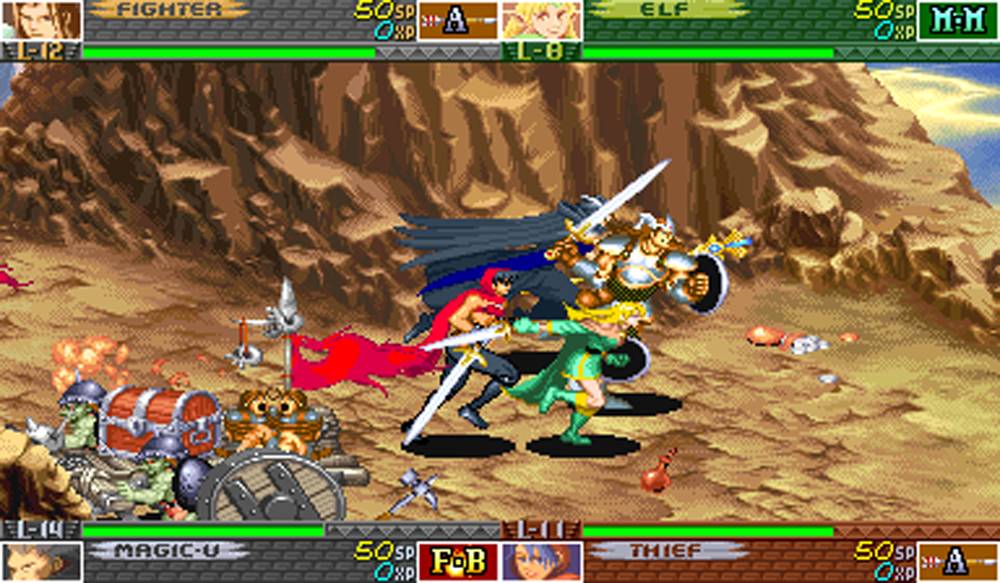Last updated on October 15, 2014
Dragon’s Crown is, fortunately or not, one of those games whose quality really rests on one or two factors total. If any of those aspects end up flawed in some sense, they end up making the core loops immensely less enjoyable, and that’s quite a shame. Even with such a delicious shell as Dragon’s Crown often is, from both a pure visual, art history, and side-scrolling beat’em up Diablo-like standpoint, the one thing that often leads to frustration remains that very same art style. Mostly it comes to down to being able to see your character in chaotic situations; in my first playthrough, I often lost track of where I was amid the chaos of glorious 2D artwork. Since Dragon’s Crown actually presents a rather stiff challenge at times, this proves a great disadvantage that colors the entire game once you get down to brass tacks.
I am absolutely maddened to say that Dragon’s Crown disappoints me on a fundamental level. I keep coming back to Vanillaware, hoping for their games to change, and they do not: the art always takes precedence over the mechanics. That’s fine for some people, but not for me. Why can’t I have both, huh? Is it really asking too much that such great animation pair up with some great stuff underneath the visual presentation? Apparently it is! This is the literal wolf in sheep’s clothing, so much so that I have a visceral reaction to the flaws Dragon’s Crown shows. That isn’t because I hate Vanilllaware’s goals, but because after decades of combined video game development experience, they should know better. And nobody will call them out on this because the “art” seems to clear all wrong. Not in my book! If the devil disguises himself as a angel of light, I think we can say looks can, and will, deceive us.
12 But what I am doing I will continue to do, so that I may cut off opportunity from those who desire an opportunity to be [e]regarded just as we are in the matter about which they are boasting. 13 For such men are false apostles, deceitful workers, disguising themselves as apostles of Christ. 14 No wonder, for even Satan disguises himself as an angel of light.15 Therefore it is not surprising if his servants also disguise themselves as servants of righteousness, whose end will be according to their deeds.
2 Corinthians 11
What pains me most is less the fundamental flaws and more all the great, wonderful improvements Dragon’s Crown does make and the tribute it presents to so many different, varying influences. Let us get into the heartbreaking part, shall we?
For those unfamiliar with Dragon’s Crown, let me explain. VanillaWare’s ten-years-in-the-making opus represents a pinnacle of the Second Age of Beat-Em Ups combined with a Diablo-esque loot metagame. VanillaWare’s founder and president, George Kamitani, originally worked on Capcom’s cult classic games Dungeon & Dragons: Tower of Doom and Shadow over Mystara. I am unsure whether Kamitani himself worked on the latter, but it merely advances the same design sensibilities of the first. Excellent games both, they tried to fuse a Japanese arcade design sensibility (i.e., beat everything up) with the RPG elements of the game’s licensed namesake. You pick a class with unique abilities (all derived from traditional D&D archetypes) and proceed into a grand adventure. Additions such as a light inventory system, camp segments (where thieves could ambush you, steal your stuff, or give you bonuses), a rote experience curve, and multiple game paths let players develop their character and see new parts of the game every time they played. They were, at least from my view, truly special games in the world of licensing, and the rare four-player cooperative option (which only Konami really pushed before) made them a must-play for anyone who loved 2D artwork and the genre as a whole.
Unfortunately, said games were paired with the aforementioned licensing issue and the lack of arcade game popularity in the United States. The few ports came out as Japanese exclusives, and were only really playable on hardware that American audiences rejected (the Saturn) with special hardware (that often desired 4MB ram card), so you can imagine the lack of enthusiasm to port older arcade games to a Playstation-centric audience enamored with three dimensional games. It’s only as of last year that said games became readily available in any sense for the Western audience. It also didn’t help when the entire genre packed up its things and took them home when arcades literally died in the US, meaning we’d never really see them again for about a decade or so.
That means, for many people, Dragon’s Crown might end up your first entry into a rather obscure genre, but I assure you it’s the culmination of VanillaWare’s work as a developer. George Kamitami stated on multiple occassions that this game in particular’s been on his mind for thirteen years since Princess Crown. Originally envisioned as a Dreamcase title, Kamitani pitched the product for over a decade and ended up rejected across the board for his ideas. I think most people would give up after years and years of publisher rejection, but here I am with a copy of Dragon’s Crown in my hand. I would call that “passion”, and passion definitely exemplified Dragon’s Crown to a tee in every design aspect. If Kamitani wanted to improve on other games in the same wheelhouse (say, Golden Axe and King of Dragons), he succeeded in many respects.

